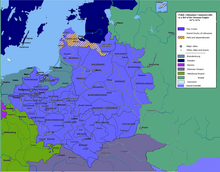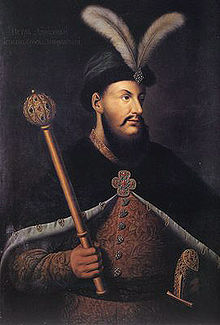| Revision as of 12:09, 30 December 2024 editHistoryk.ok (talk | contribs)Extended confirmed users1,596 editsNo edit summaryTags: Visual edit Mobile edit Mobile web edit← Previous edit | Revision as of 12:02, 1 January 2025 edit undoRxsxuis (talk | contribs)Extended confirmed users1,581 edits per MOS:VICTORYTags: Mobile edit Mobile web edit Advanced mobile editNext edit → | ||
| Line 6: | Line 6: | ||
| | place = ], (Modern day ]) | | place = ], (Modern day ]) | ||
| | result = Russo-Cossack victory | | result = Russo-Cossack victory | ||
| *Election Ivan Samoilovich as Hetman of all Ukraine | |||
| | territory = | | territory = | ||
| | combatant1 = ] ]<br>] ] | | combatant1 = ] ]<br>] ] | ||
Revision as of 12:02, 1 January 2025
| The Right-Bank campaign | |||||||
|---|---|---|---|---|---|---|---|
| Part of The Ruin (Ukrainian history) | |||||||
 Map of Right-Bank Ukraine | |||||||
| |||||||
| Belligerents | |||||||
|
|
| ||||||
| Commanders and leaders | |||||||
|
|
| ||||||
The Right-Bank Campaign of 1674 were the military actions of Moscow and Ukrainian troops under the leadership of the Left-Bank Hetman Ivan Samoilovych and Grigory Romodanovsky against the forces of the Right-Bank Hetman Petro Doroshenko, aimed at spreading royal power to Right-Bank Ukraine.
Background

With the signing of the Treaty of Buchach in 1672, a Cossack state on the right bank of the Dnieper was recognised and Moscow sought to extend its influence there. Left-bank hetman Ivan Samoilovych was instructed to negotiate with right-bank hetman Petro Doroshenko for Moscow's protection, but he feared losing his power. Doroshenko was willing to accept Moscow's supremacy under certain conditions, including armed assistance and maintaining Cossack freedoms, but Moscow preferred having separate hetmans for each bank and refused to meet all of Doroshenko’s demands. Over time, Moscow grew frustrated with Doroshenko's insistence on ceding territory for loyalty and, by 1674, felt ready to act against him, especially as support for Doroshenko had weakened among his allies.This lead to Samoilovych, fearing that he would be replaced as hetman by Doroshenko, saw this as a good opportunity to invade Right-Bank Ukraine.
Course of Events

At the beginning of 1674, Prince Romodanovski and the Hetman Samoylovich crossed to the right bank of the Dniepr. Doroshenko, having no forces, quickly lost Cherkassy, Kanev and other towns.Soon after, Doroshenko's capital,Chyhyryn, was put under siege.But with the help of the Ottomans and the fact that Chyhyryn was well fortified Romodanovsky and Samoilovich were forced to lift the siege and withdraw across the Dnieper.
Aftermath
After Samoylovich returned, deputies of ten Right Bank regiments came to the council in Pereyaslav and recognized Samoylovich as the hetman of the Right Bank Ukraine.
References
- ^ Kármán 2013, p. 146.
- Davies 2014, p. 157.
- ^ Perrie 2006, p. 510.
- Smolii 2015, p. 165.
- Allen 2006, p. 166.
- Konissky 1846, p. 174.
- Tolochko 2018, p. 202.
Bibliography
- Smolii, Valery (2015). Українська державна ідея XVII — XVIII століть: проблеми формування, еволюції, реалізації [The Ukrainian state idea of the 17th-18th centuries: problems of formation, evolution, implementation] (in Ukrainian). Kyiv. ISBN 978-5-903389-99-5.
{{cite book}}: CS1 maint: location missing publisher (link) - Smolii, Valery (2003). Гетьмани і монархи. Українська держава в міжнародних відносинах 1648 - 1714 рр. [Hetmans and monarchs. The Ukrainian state in international relations 1648 - 1714] (in Ukrainian). New York. ISBN 966-02-2431-1.
{{cite book}}: CS1 maint: location missing publisher (link) - Davies, Brain (2014). Warfare, State and Society on the Black Sea Steppe, 1500-1700. Routledge. ISBN 9781134552825.
- Kármán, Gábor (2013). The European Tributary States of the Ottoman Empire in the Sixteenth and Seventeenth Centuries. Volume 53. BRILL. ISBN 9789004246065.
- Allen, William (2006). The Ukraine, A History. Cambridge university Press. ISBN 9781107641860.
- Solovyov, Sergey (1879). История России с древнейших времён [History of Russia from Ancient Times] (in Russian). ISBN 9785170960903.
- Markevych, Mykola (1843). История малой России Том пятый [History of Little Russia Volume 5] (in Russian).
- Yavornitsky, Dmytro (1897). История запорожских казаков. Том 2 [History of the Zaporozhian Cossacks. Volume 2] (in Russian). ISBN 9783963136863.
- Perrie, Maurren (2006). The Cambridge history of Russia. Volume 1: From early Rus' to 1689. Cambridge university Press. ISBN 0-521-81227-5.
- Plokhy, Serhii (2006). The Origins of the Slavic Nations. Cambridge university Press. ISBN 978-1-139-45892-4.
- Tolochko, Petr (2018). История Украины. VI-XXI века [History of Ukraine. VI-XXI centuries] (in Russian). ISBN 978-5-9950-0873-6.
- Konissky, Georgy (1846). История русов или Малой России [History of the Rus or Little Russia] (in Russian). ISBN 9785458141956.